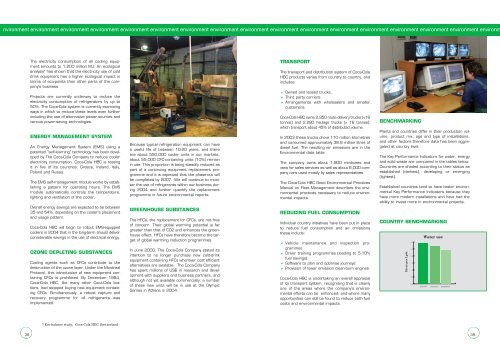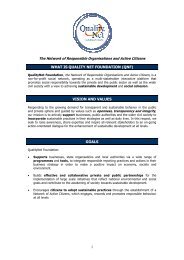APOLOGISMOS CCHBC final - Coca-Cola Hellenic
APOLOGISMOS CCHBC final - Coca-Cola Hellenic
APOLOGISMOS CCHBC final - Coca-Cola Hellenic
Create successful ePaper yourself
Turn your PDF publications into a flip-book with our unique Google optimized e-Paper software.
nvironment environment environment environment environment environment environment environment environment environment environment environment environment environment environment environment environm<br />
The electricity consumption of all cooling equipment<br />
amounts to 1,200 million MJ. An ecological<br />
analysis 4 has shown that the electricity use of cold<br />
drink equipment has a higher ecological impact in<br />
terms of eco-points than other parts of the company’s<br />
business.<br />
Projects are currently underway to reduce the<br />
electricity consumption of refrigerators by up to<br />
50%. The <strong>Coca</strong>-<strong>Cola</strong> system is currently examining<br />
ways in which to reduce these levels even further<br />
including the use of alternative power sources and<br />
various power-saving technologies.<br />
ENERGY MANAGEMENT SYSTEM<br />
An Energy Management System (EMS) using a<br />
patented “self-learning” technology has been developed<br />
by The <strong>Coca</strong>-<strong>Cola</strong> Company to reduce cooler<br />
electricity consumption. <strong>Coca</strong>-<strong>Cola</strong> HBC is testing<br />
it in five of its countries: Greece, Ireland, Italy,<br />
Poland and Russia.<br />
The EMS self-management module works by establishing<br />
a pattern for operating hours. The EMS<br />
module automatically controls the temperature,<br />
lighting and ventilation of the cooler.<br />
Overall energy savings are expected to be between<br />
35 and 54%, depending on the cooler’s placement<br />
and usage pattern.<br />
<strong>Coca</strong>-<strong>Cola</strong> HBC will begin to rollout EMS-equipped<br />
coolers in 2004 that in the long-term should deliver<br />
considerable savings in the use of electrical energy.<br />
OZONE DEPLETING SUBSTANCES<br />
Cooling agents such as CFCs contribute to the<br />
destruction of the ozone layer. Under the Montreal<br />
Protocol, this introduction of new equipment containing<br />
CFCs is prohibited. By December 1994,<br />
<strong>Coca</strong>-<strong>Cola</strong> HBC, like many other <strong>Coca</strong>-<strong>Cola</strong> bottlers,<br />
had stopped buying new equipment containing<br />
CFCs. Simultaneously, a robust capture and<br />
recovery programme for all refrigerants was<br />
implemented.<br />
Because typical refrigeration equipment can have<br />
a useful life of between 10-20 years, and there<br />
are about 550,000 cooler units in our markets,<br />
about 55,000 CFC-containing units (10%) remain<br />
in use. This proportion is being steadily reduced as<br />
part of a continuing equipment replacement programme<br />
and it is expected that the phase-out will<br />
be completed by 2007. We will continue to monitor<br />
the use of refrigerants within our business during<br />
2004 and further quantify the replacement<br />
programme in future environmental reports.<br />
GREENHOUSE SUBSTANCES<br />
The HFCs, the replacement for CFCs, are not free<br />
of concern. Their global warming potential is far<br />
greater than that of CO2 and enhances the greenhouse<br />
effect. HFCs have therefore become the target<br />
of global warming reduction programmes.<br />
In June 2000, The <strong>Coca</strong>-<strong>Cola</strong> Company stated its<br />
intention to no longer purchase new cold-drink<br />
equipment containing HFCs wherever cost efficient<br />
alternatives are available. The <strong>Coca</strong>-<strong>Cola</strong> Company<br />
has spent millions of US$ in research and development<br />
with suppliers and business partners, and<br />
although not yet available commercially, a number<br />
of these new units will be in use at the Olympic<br />
Games in Athens in 2004.<br />
TRANSPORT<br />
The transport and distribution system of <strong>Coca</strong>-<strong>Cola</strong><br />
HBC products varies from country to country, and<br />
includes:<br />
Owned and leased trucks,<br />
Third party carriers<br />
Arrangements with wholesalers and smaller<br />
customers.<br />
<strong>Coca</strong>-<strong>Cola</strong> HBC owns 2,950 route delivery trucks ( 16 tonnes),<br />
which transport about 45% of distributed volume.<br />
In 2003 these trucks drove 110 million kilometres<br />
and consumed approximately 38.6 million litres of<br />
diesel fuel. The resulting air emissions are in the<br />
Environmental data table.<br />
The company owns about 1,800 minibuses and<br />
vans for sales services as well as about 6,000 company<br />
cars used mostly by sales representatives.<br />
The <strong>Coca</strong>-<strong>Cola</strong> HBC Good Environmental Practices<br />
Manual on Fleet Management describes the environmental<br />
practices necessary to reduce environmental<br />
impacts.<br />
REDUCING FUEL CONSUMPTION<br />
Individual country initiatives have been put in place<br />
to reduce fuel consumption and air emissions<br />
these include:<br />
Vehicle maintenance and inspection programmes<br />
Driver training programmes (leading to 5-10%<br />
fuel savings).<br />
Software to plan and optimise journeys.<br />
Provision of lower emission clean-burn engines.<br />
<strong>Coca</strong>-<strong>Cola</strong> HBC is undertaking an overall appraisal<br />
of its transport system, recognising that is clearly<br />
one of the areas where the company’s environmental<br />
efforts can be enhanced, and where many<br />
opportunities can still be found to reduce both fuel<br />
costs and environmental impacts.<br />
BENCHMARKING<br />
Plants and countries differ in their production volume,<br />
product mix, age and type of installations,<br />
and other factors therefore data has been aggregated<br />
at country level.<br />
The Key Performance Indicators for water, energy<br />
and solid waste are compared in the tables below.<br />
Countries are shaded according to their status as<br />
established (darkest), developing or emerging<br />
(lightest).<br />
Established countries tend to have better environmental<br />
Key Performance Indicators because they<br />
have more modern installations and have had the<br />
ability to invest more in environmental projects.<br />
COUNTRY BENCHMARKING<br />
litres per l.p.b.<br />
3.0<br />
2.5<br />
2.0<br />
1.5<br />
1.0<br />
0.5<br />
0.0<br />
Water use<br />
Emerging Developing Established<br />
4 Eco-balance study, <strong>Coca</strong>-<strong>Cola</strong> HBC Switzerland<br />
38<br />
39







